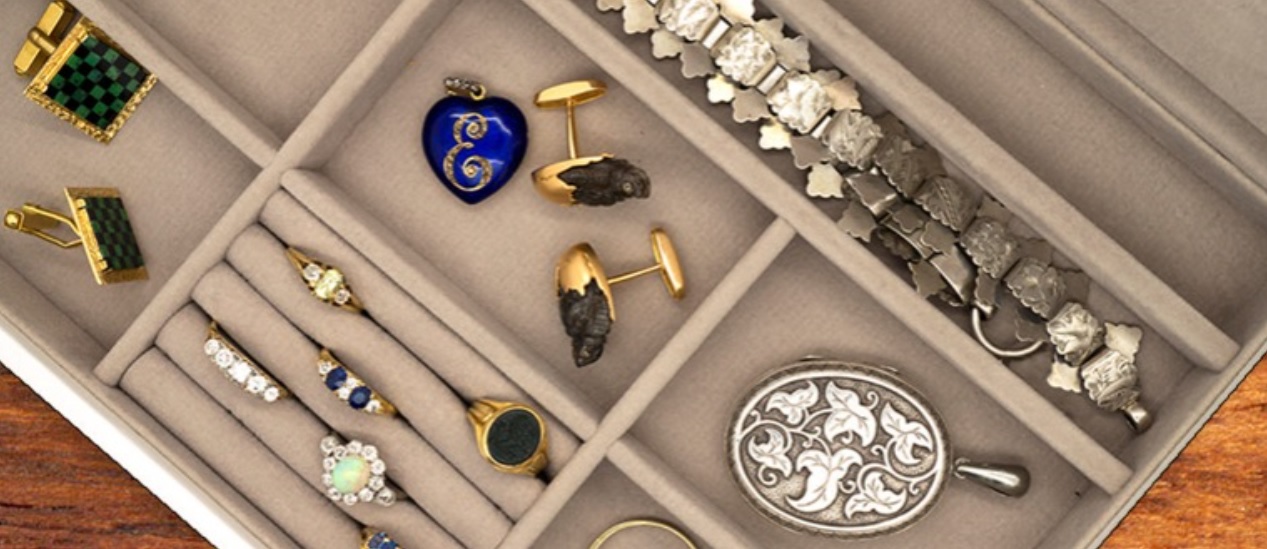Our guide to caring for antique jewellery will keep your collection sparkling. Like all the beautiful things in life, antique jewellery requires care, and here Olly Gerrish from The Antique Jewellery Company shares insider tips.
Dos
Take care not to drop, bash or scratch
Store your jewellery in a safe, soft environment – a fabric-lined jewellery box is ideal
Remove your jewellery when applying scent, lotions and potions – better still, avoid having to think about it by putting your jewellery on last when you get dressed
Polish your jewellery regularly with an old, soft cloth
If your jewellery has been neglected and needs an industrial clean, give it to your local jeweller to revive with a polishing machine
Don’ts
Avoid wearing your antique jewellery while using corrosive cleaning products. If you would rather not be constantly removing your rings keep a pair of rubber gloves to hand and cover up!
Don’t wear your jewellery to do the gardening
Don’t take your jewellery on holiday unless you are realistic about the chance of losing it in transit or the prospect of it being robbed
Don’t wear your rings in the sea! Fingers contract in the cool so they are likely to fall off
Platinum
Platinum is hardwearing and suitable to be worn every day but needs care to avoid being scratched
Platinum jewellery can be cleaned with mild soapy water and a soft toothbrush; fairy liquid is perfect if you are unsure of which soap to use
Platinum will develop a natural patina over time which can be polished off without trouble
Gold
Gold is the only precious metal that will not tarnish, as it is free of oxides. It is not, however, a particularly hard metal so care needs to be taken not to scratch it
As a rule, the higher the gold content, which is indicated by the carat weight, the softer the metal. Try to wear pieces of a similar carat weight together in order that they cause the least possible mutual harm
A soft, lint-free cloth is an effective way to keep gold jewellery looking its best and maintain its patina
Gold is particularly vulnerable to harm caused by chlorine, so care should be taken not to wear your gold in the pool
Silver
Silver tends to tarnish but is less likely to discolour the more it is worn
Either polish your jewellery with a clean soft cloth (a duster is perfect), or soak it in warm soapy water before using a soft bristle brush to remove dirt
Chlorine has an adverse affect in silver so avoid wearing it in the pool
Pearls
As an organic material, pearls are much softer than other gemstones and can be easily scratched
Pearls will maintain their lustre with regular wear. Ensure you put them on last, once you are dressed and have applied your scent and wipe them with a soft cloth as you take them off
Get your pearls restrung relatively regularly. Traditionally a good pearl stringer will tie a knot between each pearl for security, so if one falls off you won’t lose the lot!
Keep your pearls isolated from the rest of your jewellery to avoid them getting scratched
Do not use chemical cleaners, especially those containing ammonia and bleach, as this will destroy their lustre
Do not expose pearls to a high heat: there is a tendency for them to crack given they are organic and have high water content
Diamonds
Despite diamonds being extremely hard they have been known to crack and chip particularly in contact with other diamonds. Take care to store diamond pieces separately to avoid them scratching against each other
Gemstones
Gemstone hardness is based on the Mohs scale, where a high number correlates to a hard stone and a lower the number indicates a more fragile stone. It is worth taking this into account when buying, handling and storing antique jewellery
An accumulation of dirt and residue is inevitable if you wear your jewellery regularly, and can easily be cleaned. Use the Mohs scale to guage the best way to clean your jewellery
Gemstones at 7 and above on the Mohs scale can be cleaned with warm water, a splash of Fairy liquid and a soft toothbrush. For gemstones less than 7, use a soft cloth rather than a soft brush
Examples of gemstones that are vulnerable to damage by chemicals, water and even sunlight are amethyst,aquamarine, beryl, citrine, kunzite, rose and smoky quartz. In some instances overexposure may lead to discolouration
Opal, pearl and turquoise are relatively porous and should not be submerged in water for too long
Take great care when cleaning emeralds which are particularly susceptible to damage and imperfections. Ensure your emeralds do not go through an ultrasonic cleaning device as it will have an adverse effect on the oil coating that emeralds are often given to disguise flaws
We hope our guide to caring for antique jewellery
Olly Gerrish of The Antique Jewellery Company


